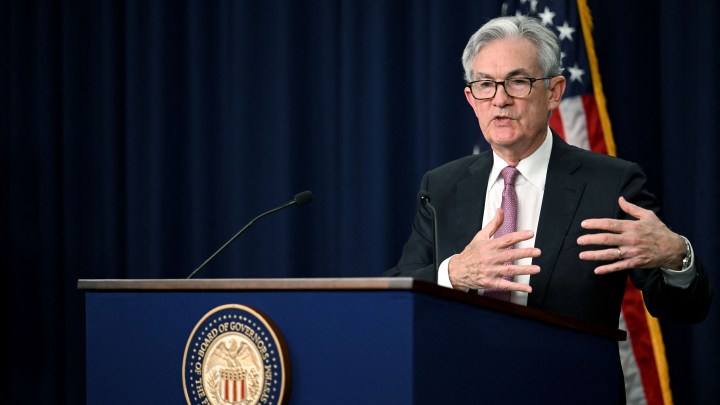
Federal Reserve attacks inflation with its largest rate hike since 1994
Share Now on:
Federal Reserve attacks inflation with its largest rate hike since 1994

The Federal Reserve on Wednesday intensified its drive to tame high inflation by raising its key interest rate by three-quarters of a percentage point — its largest hike in nearly three decades — and signaling more large rate increases to come that would raise the risk of another recession.
The move the Fed announced after its latest policy meeting will increase its benchmark short-term rate, which affects many consumer and business loans, to a range of 1.5% to 1.75%.
The central bank is ramping up its drive to tighten credit and slow growth with inflation having reached a four-decade high of 8.6%, spreading to more areas of the economy and showing no sign of slowing. Americans are also starting to expect high inflation to last longer than they had before. This sentiment could embed an inflationary psychology in the economy that would make it harder to bring inflation back to the Fed’s 2% target.
The Fed’s three-quarter-point rate increase exceeds the half-point hike that Chair Jerome Powell had previously suggested was likely to be announced this week. The Fed’s decision to impose a rate hike as large as it did Wednesday was an acknowledgment that it’s struggling to curb the pace and persistence of inflation, which has been worsened by Russia’s war against Ukraine and its effects on energy prices.
Borrowing costs have already risen sharply across much of the U.S. economy in response to the Fed’s moves, with the average 30-year fixed mortgage rate topping 6%, its highest level since before the 2008 financial crisis, up from just 3% at the start of the year. The yield on the 2-year Treasury note, a benchmark for corporate borrowing, has jumped to 3.3%, its highest level since 2007.
Even if a recession can be avoided, economists say it’s almost inevitable that the Fed will have to inflict some pain — most likely in the form of higher unemployment — as the price of defeating chronically high inflation.
Inflation has shot to the top of voter concerns in the months before Congress’ midterm elections, souring the public’s view of the economy, weakening President Joe Biden’s approval ratings and raising the likelihood of Democratic losses in November. Biden has sought to show he recognizes the pain that inflation is causing American households but has struggled to find policy actions that might make a real difference. The president has stressed his belief that the power to curb inflation rests mainly with the Fed.
Yet the Fed’s rate hikes are blunt tools for trying to lower inflation while also sustaining growth. Shortages of oil, gasoline and food are propelling inflation. The Fed isn’t ideally suited to address many of the roots of inflation, which involve Russia’s invasion of Ukraine, still-clogged global supply chains, labor shortages and surging demand for services from airline tickets to restaurant meals.
Expectations for larger Fed hikes have sent a range of interest rates to their highest points in years. The yield on the 2-year Treasury note, a benchmark for corporate bonds, has reached 3.3%, its highest level since 2007. The 10-year Treasury yield, which directly affects mortgage rates, has hit 3.4%, up nearly a half-point since last week and the highest level since 2011.
Investments around the world, from bonds to bitcoin, have tumbled in recent months on fears surrounding high inflation and the prospect that the Fed’s aggressive drive to control it will cause a recession. Even if the Fed manages the delicate trick of curbing inflation without causing a recession, higher rates will nevertheless inflict pressure on stock prices. The S&P 500 has already sunk more than 20% this year, meeting the definition of a bear market.
Other central banks around the world are also acting swiftly to try to quell surging inflation, even with their nations at greater risk of recession than the United States. The European Central Bank is expected to raise rates by a quarter-point in July, its first increase in 11 years. It could announce a larger hike in September if record-high levels of inflation persist. On Wednesday, the ECB vowed to create a market backstop that could buffer member countries against financial turmoil of the kind that erupted during a debt crisis more than a decade ago.
The Bank of England has raised rates four times since December to a 13-year high, despite predictions that economic growth will be unchanged in the second quarter. The BOE will hold an interest rate meeting on Thursday.
The 19 European Union countries that use the euro currency endured record inflation of 8.1% last month. The United Kingdom notched a 40-year high of 9% in April. Though debt service costs remain contained for now, rising borrowing costs for indebted governments threatened the eurozone with a breakup in the early part of the last decade.
Last week, the World Bank warned of the threat of “stagflation” — slow growth accompanied by high inflation — around the world.
A key reason why a recession is now likelier is that economists increasingly believe that for the Fed to slow inflation to its 2% target, it will need to sharply reduce consumer spending, wage gains and economic growth. Ultimately, the unemployment rate will almost certainly have to rise — something the Fed hasn’t yet forecast but could in updated economic projections it will issue Wednesday.
There’s a lot happening in the world. Through it all, Marketplace is here for you.
You rely on Marketplace to break down the world’s events and tell you how it affects you in a fact-based, approachable way. We rely on your financial support to keep making that possible.
Your donation today powers the independent journalism that you rely on. For just $5/month, you can help sustain Marketplace so we can keep reporting on the things that matter to you.












